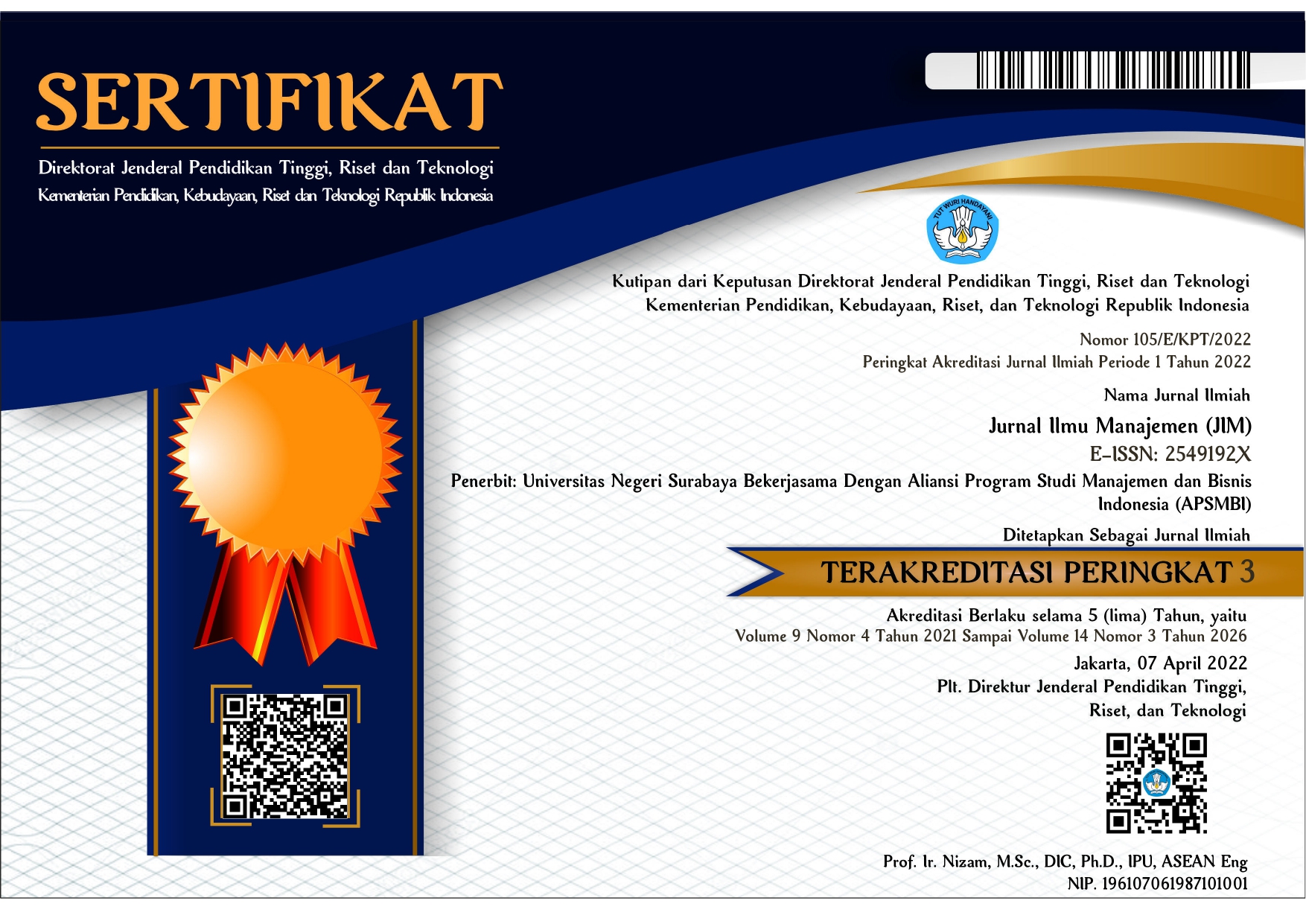Pengaruh Perceived Usefulness, Perceived Ease of Use, dan Compatibility with Lifestyle terhadap Niat Beli di Social Commerce
DOI:
https://doi.org/10.26740/jim.v10n1.p255-267Keywords:
compatibility with lifestyle, perceived ease of use, perceived usefulness, purchase intention, social commerceAbstract
Social media companies began to grow their business by innovating shopping features. This phenomenon is referred to as social commerce, which uses social media to promote and transact directly on social media. In 2022, social commerce trends are predicted to grow and account for 40% of total e-commerce transactions. This study examines the effect of perceived usefulness, perceived ease of use, and compatibility with lifestyle on purchase intention using the TikTok Shop features. This type of research is quantitative research with judgemental sampling methods. An online questionnaire with a Likert scale of 1-5 was distributed to 100 respondents via social media TikTok. Data analysis techniques use multiple linear regression tests with the help of IBM SPSS 20. The results showed that perceived usefulness, perceived ease of use, and compatibility with lifestyle had a significant and positive effect on the purchase intention. Based on the result, it is recommended that businesses that use TikTok Shop feature develop creative marketing strategies by paying attention to the usability, ease, and compatibility of the TikTok Shop features with the user's lifestyle to increase purchase intention.
References
Aristio, A. P., Supardi, S., Hendrawan, R. A., & Hidayat, A. A. (2019). Analysis on purchase intention of Indonesian backpacker in accommodation booking through online travel agent. Procedia Computer Science, 161, 885-893. https://doi.org/10.1016/j.procs.2019.11.196
bps.go.id. (2021). BPS: 270,20 Juta Penduduk Indonesia Hasil SP2020. (https://www.bps.go.id/news/2021/01/21/405/bps--270-20-juta-penduduk-indonesia-hasil-sp2020.html, diakses pada 11 Oktober 2021).
Burton-Jones, A., & Hubona, G. S. (2005). Individual differences and usage behavior: revisiting a technology acceptance model assumption. ACM SIGMIS Database: the DATABASE for Advances in Information Systems, 36(2), 58-77. https://doi.org/10.1145/1066149.1066155.
Childers, T. L., Carr, C. L., Peck, J., & Carson, S. (2001). Hedonic and utilitarian motivations for online retail shopping behavior. Journal of retailing, 77(4), 511-535. https://doi.org/10.1016/S0022-4359(01)00056-2.
Cho, Y. C., & Sagynov, E. (2015). Exploring factors that affect usefulness, ease of use, trust, and purchase intention in the online environment. International journal of management & information systems, 19(1), 21-36. https://doi.org/10.19030/ijmis.v19i1.9086.
Choshaly, S. H. (2019). Applying innovation attributes to predict purchase intention for the eco-labeled products. International Journal of Innovation Science, 11(4), 583-599. https://doi.org/10.1108/IJIS-04-2019-0038.
Davis, F. D. (1989). Perceived usefulness, perceived ease of use, and user acceptance of information technology. MIS quarterly, 13(3), 319-340.
De Kerviler, G., Demoulin, N. T., & Zidda, P. (2016). Adoption of in-store mobile payment: Are perceived risk and convenience the only drivers?. Journal of Retailing and Consumer Services, 31(July), 334-344. https://doi.org/10.1016/j.jretconser.2016.04.011.
Fatmawati, E. (2015). Technology Acceptance model (TAM) untuk menganalisis penerimaan terhadap sistem informasi di perpustakaan. Iqra: Jurnal Perpustakaan dan Informasi, 9(1), 1-13.
Haba, H., Hassan, Z., & Dastane, O. (2017). Factors leading to consumer perceived value of smartphones and its impact on purchase intention. Global Business and Management Research: An International Journal, 9(1), 42-71.
Hair, J. F., Black, W.C., Babin, B. J., & Anderson, R. E. (2019). Multivariate Data Analysis (Eight Edition). United Kingdom: Cengage Learning, EMEA
Kim, G. M., Kim, K., & Lee, H. (2013). The structure of compatibility beliefs in mobile entertainment service adoption. Journal of Information Technology Applications and Management, 20(1), 217-240. https://doi.org/10.21219/jitam.2013.20.1.217.
kompas.com. (2020). Mengenal Social Commerce, Fenomena Belanja lewat Media Sosial. (https://tekno.kompas.com/read/2020/11/25/13300057/mengenal-social-commerce-fenomena-belanja-lewat-media-sosial?page=all, diakses pada 11 Oktober 2021).
kompasiana.com. (2021). TikTok Shop Bisa Bersaing dengan Si Orange?. (https://www.kompasiana.com/dianmutiafani/614920f306310e57322775d2/tiktok-shop-bisa-bersaing-dengan-si-orange, diakses pada 11 Oktober 2021).
Kotler, Phillip & Keller, Kevin L. (2012). Marketing Management (Fourteen Edition). New Jersey: Pearson.
Lim, Y. M., Yap, C. S., & Lee, T. H. (2011). Intention to shop online : A study of Malaysian baby boomers. African Journal of Business Management, 5(5), 1711-1717. https://doi.org/10.5897/AJBM10.640.
Lu, H. P., & Su, P. Y. J. (2009). Factors affecting purchase intention on mobile shopping web sites. Internet Research, 19(4), 442-458. https://doi.org/10.1108/10662240910981399.
Lu, Y., Yang, S., Chau, P. Y. K., & Cao, Y. (2011). Dynamics between the trust transfer process and intention to use mobile payment services: A cross-environment perspective. Information & Management, 48(8), 393-403. https://doi.org/10.1016/j.im.2011.09.006.
Mirabi, V., Akbariyeh, H., & Tahmasebifard, H. (2015). A study of factors affecting on customers purchase intention. Journal of Multidisciplinary Engineering Science and Technology (JMEST), 2(1), 267-273.
Moore, G. C., & Benbasat, I. (1991). Development of an instrument to measure the perceptions of adopting an information technology innovation. Information systems research, 2(3), 192-222.
Ozturk, A. B., Bilgihan, A., Nusair, K., & Okumus, F. (2016). What keeps the mobile hotel booking users loyal? Investigating the roles of self-efficacy, compatibility, perceived ease of use, and perceived convenience. International Journal of Information Management, 36(6), 1350-1359. https://doi.org/10.1016/j.ijinfomgt.2016.04.005.
Pavlou, P. A. (2003). Consumer acceptance of electronic commerce: Integrating trust and risk with the technology acceptance model. International journal of electronic commerce, 7(3), 101-134. https://doi.org/10.1080/10864415.2003.11044275.
Ramayah, T., & Ignatius, J. (2005). Impact of perceived usefulness, perceived ease of use and perceived enjoyment on intention to shop online. ICFAI Journal of Systems Management (IJSM), 3(3), 36-51.
sirclo.com. (2020). SIRCLO Rilis Laporan Tren Perkembangan Industri E-Commerce dan Harbolnas di Indonesia Saat Pandemi. (https://www.sirclo.com/sirclo-rilis-laporan-tren-perkembangan-industri-e-commerce-dan-harbolnas-di-indonesia-saat-pandemi/, diakses pada 1 Desember 2021).
Tong, X. (2010). A cross-national investigation of an extended technology acceptance model in the online shopping context. International Journal of Retail & Distribution Management, 38(10), 742-759. https://doi.org/10.1108/09590551011076524.
Turban, E., King, D., Lee, J. K., Liang, T. P., & Turban, D. C. (2015). Electronic Commerce a Managerial and Social Networks Perspective (Eight Edition). Switzerland: Springer International Publishing.
We Are Social. (2021). Hootsuite (We Are Social): Indonesian Digital Report 2021. (https://andi.link/hootsuite-we-are-social-indonesian-digital-report-2021/, diakses pada 11 Oktober 2021).
Wen, C., Prybutok, V. R., & Xu, C. (2011). An integrated model for customer online repurchase intention. Journal of Computer information systems, 52(1), 14-23. https://doi.org/10.1080/08874417.2011.11645518.
Yang, M., Al Mamun, A., Mohiuddin, M., Nawi, N. C., & Zainol, N. R. (2021). Cashless transactions: A study on intention and adoption of e-wallets. Sustainability, 13(2), 1-18. https://doi.org/10.3390/su13020831.
Zamrudi, Z., Suyadi, I., & Abdillah, Y. (2016). The Effect of Social Commerce Construct and Brand Image on Consumer Trust and Purchase Intention. Profit: Jurnal Administrasi Bisnis, 10(1), 1-13. https://doi.org/10.21776/ub.profit.2016.010.01.1.
Downloads
Published
How to Cite
Issue
Section
License

This work is licensed under a Creative Commons Attribution-NonCommercial 4.0 International License.
 Abstract views: 5424
,
Abstract views: 5424
, PDF Downloads: 4966
PDF Downloads: 4966










